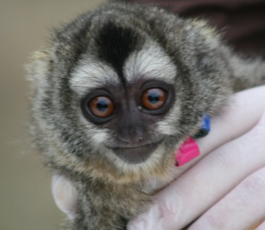
Background:
Do evolutionary specializations lead to evolutionary constraint? This appears plausible, particularly when specialization leads to loss of complex adaptations. In the owl monkey lineage, nocturnality clearly arose from a diurnal ancestor. This behavioural shift was accompanied by morphological changes in the eye and orbit and complete loss of colour vision via missense mutations in the gene encoding the short-wave sensitive visual pigment (SWS opsin). Interestingly, at least one subspecies of owl monkey, Azara’s owl monkey (Aotus azarae azarae), has regained activity in daylight. Given that all primate species that are active in daylight, including primarily diurnal species and species that are active during both day and night, have at least dichromatic colour vision, it seems reasonable to propose that dichromacy would be adaptive in A. a. azarae. With a disabled SWS opsin, the main avenue available for Azara’s owl monkeys to re-evolve colour vision is via a polymorphism in the intact X-linked opsin locus, which commonly occurs in other New World monkeys. To examine this possibility we assayed variation in the X-linked opsin of A. a. azarae, focusing on the three exons (3, 4 and 5) that control spectral sensitivity.
Results:
We found low opsin genetic variation on a population level, and no differences at the three main sites that lead to variation in spectral sensitivity in the opsins of other New World monkeys. Two rare alleles with single amino acid variants are segregating in the population, but previous functional studies indicate that these are unlikely to affect spectral sensitivity.
Conclusions:
Genetic constraint on the re-evolution of colour vision is likely operating in Azara’s owl monkey, which may affect the niche that this subspecies is able to occupy.
Read the open access article in Frontiers in Zoology by clicking here.